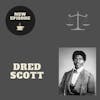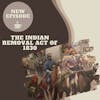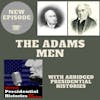Dred Scott

One of the most contentious Supreme Court decisions in United States history, Scott v. Sanford effectively robbed Black Americans of recognition as citizens.
So just who was Dred Scott? And how did his court case impact the millions of Black Americans living in the country at the time?
Tune in and find out.
SOURCES
Abraham Lincoln’s Speech on the Dred Scott Decision. Courtesy of the Freeman Institute. (LINK)
Judgment in the U.S. Supreme Court Case Dred Scott v. John F. A. Sandford; 3/6/1857; Dred Scott, Plaintiff in Error, v. John F. A. Sandford; Appellate Jurisdiction Case Files, 1792 - 2010; Records of the Supreme Court of the United States, Record Group 267; National Archives Building, Washington, DC. (LINK)
“David Blight on the Dred Scott Decision.” Africans in America. PBS. (LINK)
“Dred Scott’s fight for freedom.” Africans in America. PBS. (LINK)
Kirk, Michael. “States Which Seceded.” OSU eHistory. (LINK)
Maltz, Earl M.. Dred Scott and the Politics of Slavery. United States: University Press of Kansas, 2007.
Republican Party Platforms, Republican Party Platform of 1860 Online by Gerhard Peters and John T. Woolley, The American Presidency Project (LINK)
Weiner, Lisa. “Examining what’s involved with a Supreme Court justice’s recusal.” NPR, Morning Edition. April 15, 2022. (LINK)
United States Constitution. (LINK)
It is the judgment of this court, that it appears by the record before us that the plaintiff in error is not a citizen of Missouri, in the sense in which that word is used in the Constitution; and that the circuit court of the United States, for that reason, had no jurisdiction in the case, and could give no judgment in it. Its judgment for the defendant must, consequently, be reversed, and a mandate issued, directing the suit to be dismissed for want of jurisdiction.” Chief Justice Roger B. Taney United States Supreme Court, March 6th, 1857.
Welcome to Civics and Coffee. My name is Alycia and I am a self-professed history nerd. Each week, I am going to chat about a topic on U.S history and give you both the highlights and occasionally break down some of the complexities in history; and share stories you may not remember learning in high school. All in the time it takes to enjoy a cup of coffee.
INTRO MUSIC
Hey everyone, welcome back.
One of the most consequential court cases in American jurisprudence, the decision handed down in Dred Scott v. Sandford only further escalated the tensions bubbling to the surface in the run up to the Civil War. Finding the Constitution did not extend its privileges to anyone of African descent, the United States Supreme Court determined that Black Americans were not, nor could never be, citizens of the United States.
This week, I am diving into the Dred Scott case. What, exactly, was Scott v. Sandford all about? How did the suit come about? How did it give rise to the Republican party? And how was it repealed?
Grab your cup of coffee, peeps. Let’s do this.
Before we dive into the particulars of the case, let’s learn a bit about the plaintiff Dred Scott. Likely born in Virginia to Peter Bow around 1799, Dred Scott was born into slavery. Bow owned a farm covering 860 acres and in 1818 moved to Alabama where he leveraged his enslaved labor to attempt to farm cotton. This endeavor proved a failure, prompting the family to relocate to Missouri where they resided until Bow’s death. It is under debate whether Scott was sold before or after Bow’s death. There is some evidence indicating the sale was done by Bow himself, but some historians point to evidence indicating the sale was completed by his daughter Elizabeth after his death. In any event, in 1832 Scott was sold to Dr. John Emerson who worked as an army surgeon.
With Emerson, Scott traveled to the free state of Illinois where they resided for over two years before moving to the Wisconsin territory where Scott met and married fellow slave Harriet Robinson. Robinson was owned by a local justice of the peace and it appears her ownership was transferred to Emerson, allowing Scott and his new bride to live together as a quote unquote normal married couple. After reporting for duty at Fort Armstrong in 1833, Emerson quickly sought a reassignment. His petitions were finally approved and he was sent to the Jefferson Barracks in October of 1837. However, Emerson decided to leave Scott and his new bride behind due to the difficulties of arranging travel. Emerson then relocated to Louisiana where he got married and settled down, finally sending for Scott and his wife in April 1838.
This meant that for a number of years, Scott resided in free territory without ever making a claim to his freedom. The Scotts moved with the Emerson clan once more when they relocated to St. Louis, but decided to stay and were allowed to remain in St. Louis when Emerson was relocated yet again to Florida. Emerson moved once more to Iowa, where he passed away in December of 1843. While in St. Louis, Scott was either lent or hired out to Captain Henry Bainbridge, Mrs. Emerson’s brother in law. However, at no point is there record of Scott requesting manumission. His motivations remain unclear, but when Emerson died in 1843 and ownership transferred to Emerson’s bride, Scott finally asked for his freedom.
Scott apparently offered to purchase his freedom for $300, which was refused by Emerson’s widow and Scott proceeded to file suit, going to trial in 1847. The suit was brought forward on their behalf by Francis B. Murdoch and alleged false imprisonment and assault with Scott demanding $10 in damages. Unfortunately, they lost the case on a technicality as Scott was unable to establish ownership by Mrs. Emerson. The Missouri Supreme Court decided to allow a retrial, which was heard in 1850 by the lower courts in St. Louis. This time, Scott and his wife were successful in their claim to freedom. However, the Missouri Supreme Court got involved yet again to reverse the lower court’s decision, prompting Scott and his lawyers to file in federal court.
The case was finally heard in 1854, where the United States Circuit Court upheld the Missouri Supreme Court’s reversal. If Scott truly wanted his freedom, he had only one place left to appeal: the United States Supreme Court. In the nearly ten years the case moved through the courts, Scott went through a series of lawyers, before finally landing on Alexander P. Field and David N. Hall. In bringing suit to the Supreme Court, Scott had to prove two things: he had become free while a resident of Illinois and the Wisconsin territories and that he had remained free after his return to Missouri.
In order to understand how the Scott decision was rendered, it’s important to understand the makeup of the court. In 1856, the Supreme Court was comprised of seven justices who were appointed by pro-slavery presidents from the South, five of whome came from slave-holding families. One may be wondering why these justices felt no need to recuse themselves from deciding the Scott case. However, while there is some legal framework permitting for the recusal of Supreme Court Justices, they are irreplaceable. Unlike lower circuit courts, there is no back up for associate justices serving on the Supreme Court. I’d also argue that the justices then serving on the court saw no issue with their being on hand to decide the case.
Regardless of recusals, when Scott and his lawyers presented their case in front of the Supreme Court, the issue at hand was whether the Supreme Court had jurisdiction in the case and whether Scott was a citizen. In his analysis of the case, legal scholar Earl Maltz argues the court decided to quote “use the case as a vehicle to constitutionalize the position of the slave states on the issue of slavery in the territories” end quote. And unfortunately for Scott, the justices were not inclined to side with him. Finding that not only that Scott was not a citizen and therefore had no legal standing and therefore could not bring suit in federal courts, the justices stated that any and all individuals of African ancestry - despite their current status under the law, were not and could never be citizens of the United States. Going further, the Supreme Court stated the Missouri Compromise of 1820 was unconstitutional and that Congress had no authority to prohibit slavery in the territories.
This decision hit the country like a ton of bricks. As historian David Blight asserts, the decision in Scott v Sandford made one message perfectly clear, quote: “blacks had no rights which whites had to recognize” end quote. In Blight’s analysis, this decision basically told Black Americans they had no place in the United States and that all their fights for equality and abolition were for not. Under the rules of this decision, emancipation would provide no additional benefit as the United States would never recognize the claims to citizenship Black Americans exercised and fought for on a daily basis.
To say this decision reverberated across the nation would be an understatement. For Southerners who had claimed the right to transport their quote unquote property anywhere in the country seemingly had their interpretation reaffirmed by the highest court in the land.
But for Black Americans, both free and enslaved, it was another matter entirely. It was one thing for a slave to attempt a freedom suit in the courts. It was quite another for the court to decide that legally freed Blacks were not, and could never be, citizens of the United States. The Scott decision made stark a fork in the road in their quest for freedom: what was the benefit of trying to secure their freedom from slavery if there was nothing waiting for them on the other side? No ability to vote, or to hold property, or to otherwise enjoy the many privileges bestowed upon their white counterparts. It brought to the surface the question that seemed unanswerable: if Black Americans were not citizens of the United States, despite it being the place of their birth and the only home they’d ever known, where did they belong? Many northern free blacks decided to challenge this decision by demonstrating their claims to citizenship by exercising their legal rights, bringing suits in local courts throughout the country. The decision also prompted many states - especially those in the north - to seriously debate whether they should be bound by the Supreme Court’s ruling.
In fact, whether or not states were required to comply with the Supreme Court’s ruling played a prominent role in the rise of the Republican party and in the upcoming presidential election in 1860. Prior to his candidacy, Abraham Lincoln discussed the Scott decision, saying in part quote: “we think the Dred Scott decision is erroneous. We know the court that made it, has often overruled its own decisions, and we shall do what we can to have it overrule this” end quote. Lincoln also took the court to task for its failure recognize historical in their determination that black americans were not citizens, paying particular attention to the fact that, historically speaking, black americans were able to vote in the early days of the republic, a right bestowed only upon those classified as citizens.
The decision only further contributed to the already fractured nation. Instead of making the question of slavery a matter of settled law as the judges intended, Justice Taney only further inflamed northern citizens and split the democratic party along sectional lines, allowing for the rise of an otherwise unknown and nascent political party: the republicans.
Gearing up for the election in 1860, the republican party platform took the Scott decision and ran with it. Contrasting themselves to the other dominant party, republicans denounced the case, stating the decision amounted to quote “political heresy” and was quote “subversive of the peace and harmony of the country” end quote. Many agree that the decision handed down in Scott v Sandford was pivotal in Lincoln’s nomination for the presidency in 1860, which propelled the country toward civil war when South Caroline became the first state state in the union to secede.
And while the Scott decision had national and sweeping implications, there was still the matter of the two individuals at the heart of the case: Dred Scott and his wife Harriet. They lost. For all intent and purposes, they were destined to remain slaves for the rest of their lives. Luckily for them, fate intervened and Peter Blow’s son, the original owner of Scott, purchased the Scott family’s freedom. One of Scott’s benefactors throughout his legal battles, Blow had paid several of the legal fees Scott accrued during his decade long battle at securing freedom. Unfortunately, in a cruel twist of fate, Scott died just nine months after securing freedom.
The Dred Scott decision remained the law of the land until after the Civil War, when the 13th and 14th Amendments were added to the constitution. In case you haven’t memorized your amendments, the 13th Amendment outlawed slavery in the United States, except as punishment for crimes committed, creating a brand new problem for the country to face in the years following the war. And the 14th Amendment officially established the concept of birthright citizenship, proclaiming quote: “All persons born or naturalized in the United States, and subject to the jurisdiction thereof, are citizens of the United States and of the State wherein they reside. No State shall make or enforce any law which shall abridge the privileges or immunities of citizens of the United States; nor shall any State deprive any person of life, liberty, or property, without due process of law; nor deny to any person within its jurisdiction the equal protection of the laws” end quote.
One of the most controversial decisions rendered by the Supreme Court, Scott v Sandford added more kindling to an already raging fire and forced the country and its citizens to debate the questions of what it meant to be a citizen. In their attempt to settle the slavery question once and for all, the justices of the Supreme Court only pushed the country closer to an increasingly unavoidable conflict to determine what it was made of and what ideals it stood for. Caught in the crossfire was a couple who simply wanted what was promised to so many others in the opening lines of the declaration of independence: liberty.
Before I sign off for the week, I wanted to give one final reminder that we are getting closer to covering the Civil War. So if there is a topic, person, or event related to the Civil War you want me to cover - just let me know. While I have some ideas, your suggestions are always fascinating and I have so much fun diving into them.
And if you ever want me to cover a topic - whether or not its related to the Civil War - just let me know. You can find me on all the socials and through my website at www dot civics and coffee got com.
Alright peeps. Enjoy yourselves. I’ll see you next week.
Thanks for tuning and I hope you enjoyed this episode of Civics & Coffee. If you want to hear more small snippets from american history, be sure to subscribe wherever you get your podcasts. Thanks for listening and I look forward to our next cup of coffee together.
OUTRO MUSIC
Listener Favorites
Not sure where to begin? Take a listen to some fan favorites.

























